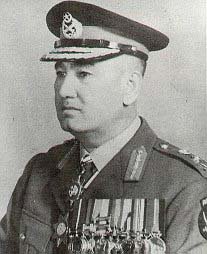| Commander-in-Chief of the Pakistan Army | |
|---|---|
| پاک فوج کے کمانڈر انچیف | |
 Flag of the Pakistan Army | |
| Ministry of Defence Army Secretariat-I at MoD[1] | |
| Abbreviation | C-in-C |
| Residence | Rawalpindi Cantonment |
| Seat | General Headquarters Rawalpindi Cantonment in Punjab, Pakistan |
| Nominator | Governor General of Pakistan, Prime Minister or President of Pakistan |
| Appointer | Governor General of Pakistan, Prime Minister or President of Pakistan |
| Term length | Not fixed |
| Formation | 15 August 1947 |
| First holder | Gen. Frank Messervy |
| Final holder | Lt. Gen. Gul Hassan Khan |
| Abolished | 3 March 1972 |
| Succession | Chief of Army Staff |
| Unofficial names | Army chief |
| Deputy | Chief of Staff of the Pakistan Army |
The Commander-in-Chief of the Pakistan Army (abbreviation: C-in-C of the Pakistan Army) was the professional head of the Pakistan Army from 1947 to 1972.[2] The C-in-C was directly responsible for commanding the army. It was an administrative position and the appointment holder had main operational command authority over the army.[3]
Direct appointments to the command of the Pakistan Army came from the British Army Council until 1951, when the first native Pakistani commander-in-chief (General Ayub Khan) was nominated and appointed by the Government of Pakistan.[4][5]
The C-in-C designation was changed to 'Chief of Army Staff' in 1972; General Tikka Khan was the first person to hold the new title. Six generals have served as C-in-C, the first two of them were native British and the post's name was derived from the post of Commander-in-Chief of the British Indian Army.[6][7][8][9][10]
- ^ MoD, Ministry of Defence. "Organogram of MoD" (PDF). Ministry of Defence (Pakistan). Ministry of Defence Press. Retrieved 22 July 2017.
- ^ Bajwa, Kuldip Singh (2003). "Kashmir Valley saved". Jammu and Kashmir War, 1947-1948: Political and Military Perspective (googlebooks) (1st ed.). New Delhi, India: Har-Anand Publications. p. 320. ISBN 9788124109236. Retrieved 3 December 2017.
- ^ Siddiqi, Abdurrahman (2020). General Agha Mohammad Yahya Khan: The Rise & Fall of a Soldier, 1947-1971. Karachi, Pakistan: Oxford University Press. ISBN 9780190701413.
- ^ Khan, Mohammad Ayub (1967). Friends Not Masters: A Political Autobiography. Karachi, Pakistan: Oxford University Press. ISBN 9789697553006.
- ^ Harmon, Daniel E. (2008). Pervez Musharraf: President of Pakistan: Easyread Super Large 20pt Edition. ReadHowYouWant.com. ISBN 9781427092038. Retrieved 3 December 2017.
- ^ Cheema, Pervaiz Iqbal (2002). "Defence Administration". The Armed Forces of Pakistan (google books) (1st ed.). New York, U.S.: NYU Press. p. 225. ISBN 9780814716335. Retrieved 25 July 2017.
- ^ Shabbir, Usman (2003). "Command and Structure control of the Pakistan Army". pakdef.org. PakDef Military Consortium. Archived from the original on 7 January 2019. Retrieved 24 July 2017.
- ^ Cloughley, Brian (2016). A History of the Pakistan Army: Wars and Insurrections. Skyhorse Publishing, Inc. ISBN 9781631440397. Retrieved 24 July 2017.
- ^ "Pakistan: Army and Paramilitary Forces". Factba.se. Archived from the original on 7 January 2019. Retrieved 16 December 2013.
- ^ "The Army Chief's". www.pakistanarmy.gov.pk. Archived from the original on 4 December 2013. Retrieved 16 December 2013.
